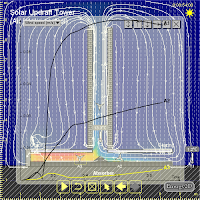 |
| The day/night cycle of an SUT |
The solar updraft tower is a new-concept clean energy power plant for generating electricity from the sun. Sunshine falling on a greenhouse collector structure around the base of a tall chimney heats the air within it. The resulting convection causes air to rise up in the tower, driving wind turbines to produce electricity. In 2011, a plan of building a massive solar updraft tower in Arizona was announced (for more information, see this CNN report: Can hot air be the free fuel of the future?).
Compared with other solar technologies, solar updraft towers have many significant advantages. For example, it does not require water; it can be built in barren areas; it can still generate electricity after dark; its lifetime is much longer than solar panel arrays; and so on. Engineering-wise, it is a sound concept. The rest is a political will to get it banked and constructed. Let’s hope it wouldn’t take too long.
 |
| Streamline analysis of air intake |
Instead of waiting for it to come true, why not go to our Energy2D website and see a bunch of simulations? You can even start to investigate it with our powerful Energy2D software. For example, you can turn the sunlight on and off to investigate how the heat absorbed during the day can still be released at night to drive the turbines. You can adjust the height of the tower to get an idea of why engineers want to build an insanely tall tower that rivals the height of Burj Khalifa in Dubai, the tallest building in the world. You can even use Energy2D’s comprehensive analysis tools to study what happens when you block one of the air intake entrances.
The opportunities of inquiry with Energy2D are practically endless. You don’t have to wait for someone to erect a solar updraft tower to explore about the technology — you can do it now and the concept of a new technology is only a few mouse clicks away from you. Why not show these simulations and your investigations to your students to get them interested in clean energy today?